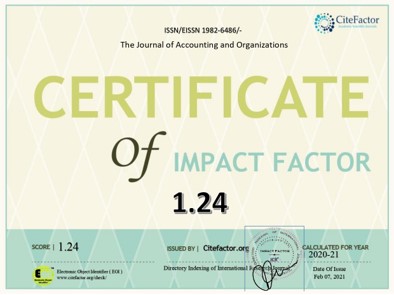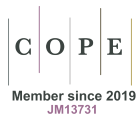Avaliação da capacidade informacional das demonstrações contábeis e fiscais no mercado secundário de títulos públicos brasileiro
DOI:
https://doi.org/10.11606/issn.1982-6486.rco.2021.169063Palavras-chave:
Títulos públicos, Capacidade informacional, Contabilidade pública, Setor públicoResumo
Este estudo de propôs avaliar a capacidade informacional das demonstrações contábeis e fiscais, a partir da construção de modelos que permitam identificar a relação entre um conjunto de variáveis representativas e o apreçamento dos títulos públicos do governo federal brasileiro. Para tanto, foram levantadas as séries históricas das taxas de juros de compra dos principais títulos públicos e mais 43 variáveis contábeis e fiscais, no período de 2010 a 2018. Após a estimação dos parâmetros através de modelos de regressão linear, os resultados sugerem que informações constantes no Balanço-Geral da União (BGU), Tesouro Transparente (TT), Relatório de Gestão Fiscal (RGF) e informações do Banco Central do Brasil (BCB), possuem capacidade predizer, refletir e/ou confirmar a expectativas dos investidores de títulos públicos. As implicações práticas desses achados contribuem como referências para melhorar a comunicação com os principais stakeholders das informações contábeis e fiscais do Governo Federal, em especial os investidores de títulos públicos. Ademais, permitem conhecer as potencialidades de cada relatório, possibilitando o uso complementar destas informações para fins de planejamento e acompanhamento da situação patrimonial e fiscal do Governo Federal.
Downloads
Referências
Andersen, C. M., & Bro, R. (2010). Variable selection in regression – a tutorial. Journal of chemometrics, 24(11‐12), 728-737. https://doi.org/10.1002/cem.1360
Ball, R. & Brown, P. (1968) An empirical evaluation of accounting income numbers. Journal of accounting research, 6(2), 159-178. https://doi.org/10.2307/2490232
Banco Central do Brasil. (2019) Sistema gerador de series temporais. Recuperado em 2 agosto, 2019, de: <https://www.bcb.gov.br/?SERIESTEMP>.
Barth, M. E., Beaver, W. H., & Landsman, W. R. (2001) The relevance of the value relevance literature for financial accounting standard setting: another view. Journal of accounting and economics, 31(1-3), 77-104.
Beaver, W., Kettler, P., & Scholes, M. (1970) The association between market determined and accounting determined risk measures. The Accounting Review, 45(4), 654-682.
Beaver, W. H.; Clarke, R., & Wright, W. F. (1979) The association between unsystematic security returns and the magnitude of earnings forecast errors. Journal of accounting research, 17(2), 316-340.
Botelho, B. C. & Lima, D. V. (2015) Experiências internacionais e desafios dos governos dos países na transição da contabilidade pública para o regime de competência. Revista Evidenciação Contábil & Finanças, 3(3), 68-83.
Brugni, T. V., Fávero, L. P. L., Flores, E. S., & Beiruth, A. X. (2015) O vetor de causalidade entre lucro contábil e preço das ações: existem incentivos para a informação contábil seguir o preço no Brasil? Contabilidade Vista & Revista, 26(1), 79-103.
Burchell, S., Clube, C., Hopwood, A., Hughes, J., & Nahapiet, J. (1980) The roles of accounting in organizations and society. Accounting, organizations and society, 5(1), 5-27.
Chan, J. L. (2003). Government accounting: an assessment of theory, purposes and standards. Public Money & Management, 23(1), 13-20.
Copeland, T., Weston, F., & Shastri, K. (2005) Financial Theory and corporate policy. 4th. Ed. Pearson Addison Wesley.
Comitê de Pronunciamentos Contábeis. (2011) CPC 00. Estrutura conceitual para elaboração e divulgação de relatório contábil-financeiro, 2011. Brasília. Recuperado em 2 agosto, 2019, de: <http://www.cpc.org.br/Arquivos/Documentos/147_CPC00_R1.pdf>.
Costa, C. C. M., Ferreira, M. A. M., Braga, M. J., & Abrantes, L. A. (2015). Fatores associados à eficiência na alocação de recursos públicos à luz do modelo de regressão quantílica. Revista de Administração Pública, 49(5), 1319-1347. https://doi.org/10.1590/0034-7612130868
Cupertino, C. M. & Lustosa, P. R. B. (2004) O modelo Ohlson de avaliação de empresas: tutorial para utilização. BBR - Brazilian Business Review, 1(1), 1-16.
Fama, E. (1970) Efficient capital markets: a review of theory and empirical work. The Journal of Finance, 25(2), 383-417. http://doi.org/10.2307/2325486
Fama E. (1991) Efficient Capital II. The Journal of Finance, 5, 1575 - 1617. https://doi.org/10.1111/j.1540-6261.1991.tb04636.x
Guyon, I., & Elisseeff, A. (2003). An introduction to variable and feature selection. Journal of machine learning research, 3, 1157-1182.
Hair, J. F., Black, W. C., Babin, B. J., & Anderson, R. E. (2005) Multivariate Data Analysis. Upper Saddle River: Prentice Hall.
Harrell, F. E. (2001). Regression modeling strategies: with applications to linear models, logistic regression, and survival analysis. New York: Springer.
Hendriksen, E. S.; Van Breda, M. F. (1999) Teoria da Contabilidade. Tradução de Antonio Z. Sanvicente. São Paulo: Atlas.
Holthausen, R. W. & Watts, R. L. (2001) The relevance of the value-relevance literature for financial accounting standard setting. Journal of accounting and economics, 31(1-3), 3-75.
Hosmer, D.W. & Lemeshow, S. (1989) Applied Logistic Regression. Nova Iorque: John Wiley & Sons.
Instituição Fiscal Independente. (2018) Análise da situação da União com base no seu balanço patrimonial. Estudo Especial nº. 06, 2018. Brasília. Recuperado em 2 agosto, 2019, de: <https://www12.senado.leg.br/ifi/publicacoes-1/estudos-especiais/2018/agosto/estudo-especial-no-06-analise-da-situacao-da-uniao-com-base-no-seu-balanco-patrimonial-ago-2018>.
Instituto Brasileiro de Geografia e Estatística. (2019) Índice Nacional de Preços ao Consumidor Amplo – IPCA. Recuperado em 19 julho, 2019, de: <https://ww2.ibge.gov.br/home/estatistica/indicadores/precos/inpc_ipca/defaultinpc.shtm>.
International Monetary Fund & The World Bank. (2007) Strengthening Debt Management Practices - Lessons from Country Experiences and Issues Going Forward: Background Paper.
Kim, D. (2001) The determinants of municipal bonds returns: multifactor return model based on Market, state, and governamental accounting information. Doctoral dissertation, Temple University, Philadelphia, United States of America.
Meurer, R. (2014) Emissão de títulos da dívida pública brasileira em reais no exterior: contexto e características. Revista de economia contemporânea, 18(2), 185-209. https://doi.org/10.1590/141598481822
Miller, D. P. & Puthenpurackal, J. (2002) The Costs, Wealth Effects and Determinants of International Capital Raising: Evidence from Public Yankee Bonds, Journal of Financial Intermediation, 11(4), 455-485. https://doi.org/10.1006/jfin.2002.0342
Mishkin, F. S. (2000) Moedas, bancos e mercados financeiros. 5 ed. Rio de Janeiro: LTC.
Ohlson, J. A. (1995) Earnings, book values, and dividends in equity valuation. Contemporary accounting research, 11(2), 661-687. https://doi.org/10.1111/j.1911-3846.1995.tb00461.x
Oliveira, G. C., Vazquez, D. A., & Wolf, P. J. W. (2018) Evolução da dívida e da necessidade de financiamento do setor público no Brasil (1995-2016): um balanço do período pós-real. Revista de Economia Contemporânea, 21(3). https://doi.org/10.1590/198055272133
O’Hanlon, J. (1991) The relationship in time between annual accounting returns and annual stock market returns in the U.K. Journal of business finance and accounting, 18(3). https://doi.org/10.1111/j.1468-5957.1991.tb00596.x
Platt Neto, O. A., Cruz, F., Ensslin, S. R., & Ensslin, L. (2009) Publicidade e transparência das contas públicas: obrigatoriedade e abrangência desses princípios na administração pública brasileira. Contabilidade Vista & Revista, 18(1), 75-94.
Ross, S., Westerfield, R., & Jaffe, J. (2002) Corporate Finance. 6 ed. New York: McGraw-Hill.
Schucknecht, L.; Hagen, J., & Wolswijk, G. (2009) Government risk premiums in the bond market: EMU and Canada. European Journal of Political Economy, 25(3), 371-384.
Secretaria do Tesouro Nacional. (2019a) Contabilidade pública. Recuperado em 30 agosto, 2020, de: <https://www.gov.br/tesouronacional/pt-br/contabilidade-e-custos>.
Secretaria do Tesouro Nacional. (2019b) Dívida Pública Federal: Relatório Anual 2018. Brasília: Secretaria do Tesouro Nacional.
Secretaria do Tesouro Nacional. (2019c) Histórico de preços e taxas. Recuperado em 30 agosto, 2020, de: <https://sisweb.tesouro.gov.br/apex/f?p=2031:2:0::::>.
Secretaria do Tesouro Nacional. (2019d) Mercado Secundário. Brasília. Recuperado em 30 agosto, 2020, de: < https://www.gov.br/tesouronacional/pt-br/divida-publica-federal/mercado-interno/mercado-secundario>.
Secretaria do Tesouro Nacional. (2019e) Tesouro Transparente. Recuperado em 30 agosto, 2020, de: <http://www.tesourotransparente.gov.br>.
Summers, G. F. (2003) Public sector accounting disclosure quality and municipal bond interest costs: the case of school districts bonds. Doctoral dissertation, Faculty of the C. T. Bauer College of Business, University of Houston, Houston, United States of America.
Suzart, J. A. S. (2013) Informações contábeis governamentais e o mercado secundário de títulos públicos: um estudo sob a ótica da value relevance no Brasil. Tese de doutorado, Universidade de São Paulo, São Paulo, Brasil.
Suzart, J. A. S. (2014) As informações contábeis e as agências de classificação de risco de crédito. Revista de Contabilidade e Controladoria, 6(3), p. 108-126. https://doi.org/10.5380/rcc.v6i3.35856
Valente, N. T. Z. & Fujino, A. (2016) Atributos e dimensões de qualidade da informação nas Ciências Contábeis e na Ciência da Informação: um estudo comparativo. Perspectivas em Ciência da Informação, 21(2), 141-167. https://doi.org/10.1590/1981-5344/2530
World Government Bonds. (2019) Brazil Credit Rating. Recuperado em 19 julho, 2019, de: <http://www.worldgovernmentbonds.com/credit-rating/brazil>
Downloads
Publicado
Edição
Seção
Licença
Copyright (c) 2021 Revista de Contabilidade e Organizações

Este trabalho está licenciado sob uma licença Creative Commons Attribution-NonCommercial-NoDerivatives 4.0 International License.
A RCO adota a política de Acesso Livre (Libre Open Access), sob o acordo padrão Creative Commons (CC BY-NC-ND 4.0). O acordo prevê que:
- A submissão de texto autoriza sua publicação e implica compromisso de que o mesmo material não esteja sendo submetido a outro periódico. O original é considerado definitivo;
- Autores mantêm os direitos autorais e concedem à revista o direito de primeira publicação, com o trabalho simultaneamente licenciado sob a Licença Creative Commons Attributionque permite o compartilhamento do trabalho com reconhecimento da autoria e publicação inicial nesta revista;
- Autores têm autorização para assumir contratos adicionais separadamente, para distribuição não-exclusiva da versão do trabalho publicada nesta revista (ex.: publicar em repositório institucional ou como capítulo de livro), com necessário reconhecimento de autoria e publicação inicial nesta revista;
- Autores têm permissão e são estimulados a publicar e distribuir seu trabalho online (ex.: em repositórios institucionais ou na sua página pessoal) antes ou durante o processo editorial, já que isso pode gerar alterações produtivas, bem como aumentar o impacto e a citação do trabalho publicado (Veja O Efeito do Acesso Livre);
- A revista não paga direitos autorais aos autores dos textos publicados;
- O detentor dos direitos autorais da revista, exceto os já acordados no acordo de Libre Open Access (CC BY-NC-ND 4.0), é o Departamento de Contabilidade da Faculdade de Economia, Administração e Contabilidade de Ribeirão Preto da Universidade de São Paulo.
Não são cobradas taxas de submissão ou de publicação.
São aceitos até 4 autores por artigo. Casos excepcionais devidamente justificados poderão ser analisados pelo Comitê Executivo da RCO. São considerados casos excepcionais: projetos multi-institucionais; manuscritos resultantes da colaboração de grupos de pesquisa; ou que envolvam grandes equipes para coleta de evidências, construção de dados primários e experimentos comparados.
É recomendada a ordem de autoria por contribuição, de cada um dos indivíduos listados como autores, especialmente no desenho e planejamento do projeto de pesquisa, na obtenção ou análise e interpretação de dados e redação. Os autores devem declarar as efetivas contribuições de cada autor, preenchendo a carta ao editor, logo no início da submissão, responsabilizando-se pelas informações dadas.
É permitida a troca de autores durante todo o processo de avaliação e, antes da publicação do manuscrito. Os autores devem indicar a composição e ordem final de autoria no documento assinado por todos os envolvidos no aceite para publicação. Caso a composição e ordem de autoria seja diferente da informada anteriormente no sistema, todos autores anteriormente listados deverão se manifestar favoráveis.
No caso de identificação de autoria sem mérito ou contribuição (ghost, guest or gift authorship), a RCO segue o procedimento recomendado pela COPE.







